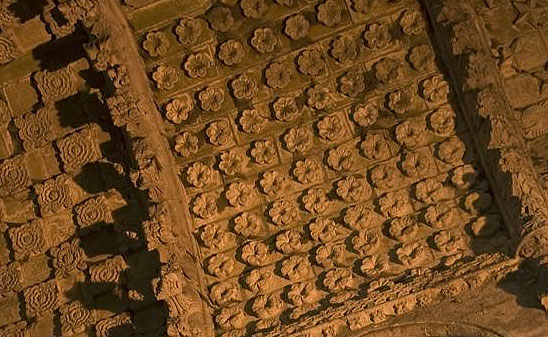Rosslyn Chapel Cubes
By Stuart Mitchell
In 2003 my father (T.J. Mitchell) introduced me to one of the wonders of science and music architecture, Rosslyn Chapel (8 miles from Edinburgh where I live).
I may have been fortunate in the fact that I live close by to the chapel and made it easy for me access and research its many wonders, but it was its musical mystery and its connection to a source of geometry as defined by nature that really caught my attention. The Lady Choir section of the chapel is covered by 215 cubes and rectangle, protruding on stems from 14 arches that criss-cross one another and carved into each cube are 13 geometric patterns repeated throughout the entire 215 cubes in a sequentially. The patterns are only found ‘collectively’ within one (known) science, that of Cymatics or Chladni patterns. These are produced very easily by laws of resonance and vibration by the use of some very basic materials which were readily available in medieval times.

The question on everybody’s lips is WHY a 15th Century and an ‘apparently undiscovered’ science such as cymatics should require such an intricate and important feature embedded into its carvings for all to see. With the help of my colleagues Richard Merrick and John Reid we can begin to explain the importance of exactly why it was so important to the designers of Rosslyn Chapel to impart this information into such a high degree.
First we have to understand the reason for using cymatics as a 15th Century CD’ to impart the knowledge of own science.
‘The point that cymatic geometry is relative to the fundamental resonant frequency of its container (e.g., a pentagon produced by a cello), it occurs either relative to either timbre or harmony. This is important for several reasons.
For instance, a timbral pentagon is produced by the interference pattern of the 4th harmonic wave partial against the 1st partial, or fundamental frequency. This is a 4:1 ratio or double octave in the harmonic series. A music harmony pentagon is produced by the interference pattern of a perfect fifth, or 3:2 ratio interval. The reason for the difference is because the harmonics in a single tone is linear and symmetrical; whereas, two or more tones in pitch space are curved and asymmetrical according to the golden mean. I present a simple conversion equation in my book to convert between linear and curved harmonic space, but this is not my point here.
My point is that cymatic geometry is always a function of its container. For the cello, the container is its resonant body and the frequency of that. The pentagon only has meaning relative to the container of that particular cello and is not absolute for other instruments that might play along. This means that to create music that corresponds to a particular set or series of cymatic geometries, each instrument must be measured to determine its fundamental resonant frequency AND the music composed such that each instrument or perhaps section is featured at the right time to play specific shapes. Not so easy, but very meaningful if you want to construct the image of a landscape.
As it applies to Rosslyn, there are two related points:
1. The music of the cubes was probably intended to be in the ‘key’ of the fundamental frequency of the chapel’s interior. This is determined in the usual way by setting up microphones with a loudspeaker system and increasing the volume while pulling back frequency ranges on an equalizer (eliminating feedback frequencies). Whatever this frequency turns out to be is the reference key for the Motet.
2. The tuning of the instruments would ideally be tuned to the geometry of the chapel. At the back of my book (Interference) I propose a tuning I call 81-AET which emphasizes resonance and the ‘holy of holies’ architecture of the chapel which is 81 feet long. Consider that 1/81 = 0.012345679, or compatible with the harmonic series. Much more to this, but you get the idea.
3. I predict that the musical cubes are intended to represent a container. Not just any container, but the same container of the chapel itself and that they have the same proportional dimension of the interior in the ratio of 81 X 68 X 40.5. That is, each cube represent the ‘key’ within which it should be played. I think this key and the 81-AET tuning might be needed to properly reproduce the cymatic geometry in the chapel. But even if it isn’t, I think this will sound magnificent.’
(Richard Merrick)
In a nutshell, what Richard John and I are proposing is that Cymatics is natures ‘geometric tuning system’ and its presence within nature is a powerful representation of a musical/sound system inherent in the fabric of space and time, therefore, the chapel, being a shrine to nature is sharing with the world the very music and synthesis functional within nature.
As above so below, all the world and everything else in our present universe is a symphony of light, sound and colour, intelligently controlled and developed by nature herself. The designers of Rosslyn went to great lengths to impart this knowledge to us in the hope that we, as a species could benefit from its effects and resonate more affectionately and truly with nature.
Content courtesy of Stuart Mitchell









